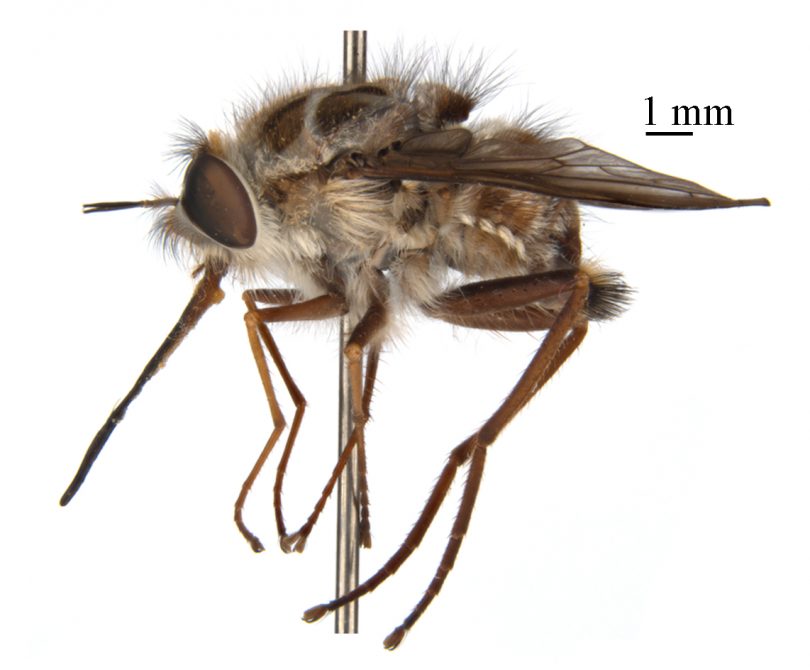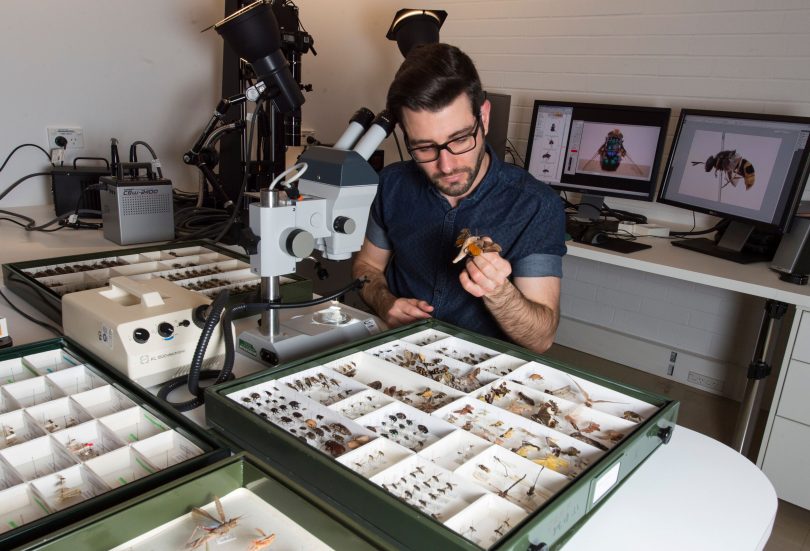
Canberra PhD student Xuankun Li named a bee fly after the Game of Thrones’ Night King because it reigns in winter and has a crown of spine-like hairs. Photos: CSIRO.
Have you ever wanted to name a species? According to Canberra scientist ‘Bry the Fly Guy’ (aka Bryan Lessard), it’s the “most fun a taxonomist can have”!
And it sounds like there’s been some fun to be had lately with the Canberra-headquartered CSIRO naming 230 new species during the past year.
Just one of those was a bee fly named Paramonovius nightking after the Game of Thrones’ Night King because it reigns in winter and has a crown of spine-like hairs.
Other newly named species have ranged from a cusk eel named Barathronus algrahami after fish collection manager Al Graham, to a tiny soldier fly from Judbarra National Park in the Northern Territory which Dr Lessard named Prosopochrysa lemannae in honour of insect technician Cate Lemann.

Canberra scientist ‘Bry the Fly Guy’ (aka Bryan Lessard) from the CSIRO has recently named two soldier flies and says it is a lot of fun but also has a serious side.
Dr Lessard, who is an entomologist at the CSIRO’s National Research Collections Australia, said that despite the fun involved, naming a new species also has a serious side.
This is because a species without a scientific name is invisible to science and conservation and Australia has only named 20-25 per cent of its half a million species.
“Scientists across the country name around 1000 new species each year. At the current rate it will take another 350 years just to know what exists,” Dr Lessard said.
“Australia needs a step change in biodiversity discovery and at CSIRO we’re pulling together many strands of science to deliver that.
“We’re using AI, machine learning, genomics, digitisation and big data informatics to change the way we use the 15 million specimens in our research collections.”

A cusk eel species has been named Barathronus algrahami after fish collection manager Al Graham.
Dr Lessard said the driver of this action is the value of Australia’s biodiversity and its benefits.
“Our biodiversity runs the planet. It cycles nutrients, sequesters carbon, pollinates crops and cleans the air we breathe and the water we drink. We literally couldn’t live without it,” Dr Lessard said.
He said that Australia’s native plants and animals directly support billions of dollars of industries such as fisheries and forestry. They are rich sources of germplasm for crops like cotton, soybean and macadamias and can be explored to find useful new bioactive molecules and novel materials.
“Native plants and animals are of deep cultural significance to Indigenous communities and simply being out in nature has many health benefits,” Dr Lessard said.
One of the groups Dr Lessard studies, soldier flies, has an estimated 300 Australian species but only 150 of them have names.
Like many insects, some undescribed soldier fly species have waited in the insect collection for decades for a taxonomist to describe and name them so they can be formally recognised.
“One of the soldier flies I named is from Chillagoe in Queensland,” Dr Lessard said.
“It’s so different from other Australian soldier flies that it belongs to a new genus, which is the next level up from species.
“I named it Scutellumina parvatra – that means little black fly with no shoulder spines.”

Dr Bryan Lessard named this soldier fly from Queensland Scutellumina parvatra, which means ‘little black fly with no shoulder spines’.
There are a number of conventions to follow when naming a species including making sure the name isn’t insulting or derogatory – and not naming a species after yourself!
The scientific name has to be unique for each species and is made up of both a genus name, which comes first, and a species name.
Along with the new insect and fish species, staff of the Australian National Herbarium have named six new plants species, including two daisies, two orchids, a lobelia and a trumpet vine.
The next generation of taxonomist is also getting involved in the name game.
“Xuankun Li, who named the bee fly Paramonovius nightking, is a PhD student at CSIRO and a huge fan of Game of Thrones, proving that inspiration for new species’ names can come from anywhere,” Dr Lessard said.
Original Article published by Glynis Quinlan on The RiotACT.






